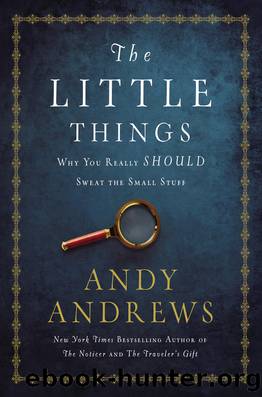The Little Things by Andy Andrews

Author:Andy Andrews
Language: eng
Format: epub
Publisher: Thomas Nelson
Published: 2017-02-10T00:00:00+00:00
Ten
A Little Thing . . . like an air rifle
In his hand was the knurled stock of as coolly deadly-looking a piece of weaponry as ever I had laid eyes on.
—JEAN SHEPHERD
THE LAND MASS NOW OCCUPIED BY THE UNITED States of America was once separated into four parts by casual borders and owned by four different countries—England, France, Spain, and a very young United States. This fact, I am fairly certain, you already know.
There is, however, a footnote to the larger story—one virtually overlooked by historians—about how the youngest country came to own it all. The tale concerns a two-year period, from 1804 to 1806, and a single iconic gun that was never even fired at a person. Yet it was used again and again, becoming one of the most influential weapons in history. There is no doubt that this one gun—on multiple occasions—bore much of the responsibility for America’s expansion into its current geographical form.
Care to guess what kind of gun it was? The Kentucky long rifle, you say? Perhaps your vote would go to Samuel Colt’s six-shooter. Anyone for the Winchester lever-action repeating rifle?
No, no, and no.
Good guesses all. But those are not even close to being the gun that enabled the United States to stretch from “sea to shining sea.”
That gun was the air rifle.
Intriguing, isn’t it? After all, what’s the first thing that pops into your mind when you read the words air rifle? If your brain immediately conjures up scenes from the movie A Christmas Story, you are not alone: An air rifle? You mean “an official Red Ryder carbine-action, two-hundred-shot range model.” The one “with a compass in the stock and this thing which tells time.”
Most people consider the lowly air rifle to be little more than a toy—the kind of present a nine-year-old would long for. But as I stated, there is a tale of power in its past. Real power. The kind of power that can forge nations.
In other words, more power than you’d ever need to “shoot your eye out”!
In May 1804, the Corps of Discovery set off from Missouri headed for parts unknown. Totaling thirty-three men in their “permanent party,” they had been commissioned by the third president of the United States, Thomas Jefferson, to “find whatever is out there.” Missouri was the country’s western edge at the time, and most Americans (including Congress) were of the opinion that whatever was out there, the French, Spanish, and British could darn well have it. Jefferson disagreed.
The president had chosen a US Army captain, Meriwether Lewis, to head the expedition. Lewis then selected his friend William Clark as second in command. The officially stated purpose of the journey was to discover a water route to the Pacific Ocean, and Jefferson’s public justification for the effort was based on the possibility of greater commerce. Privately, however, he had different reasons altogether.
Jefferson had heard stories of the vast lands to the west. In addition, he had read Captain James Cook’s account of his third
Download
This site does not store any files on its server. We only index and link to content provided by other sites. Please contact the content providers to delete copyright contents if any and email us, we'll remove relevant links or contents immediately.
Man-made Catastrophes and Risk Information Concealment by Dmitry Chernov & Didier Sornette(4734)
The Revenge of Geography: What the Map Tells Us About Coming Conflicts and the Battle Against Fate by Kaplan Robert D(3597)
Zero Waste Home by Bea Johnson(3288)
COSMOS by Carl Sagan(2950)
In a Sunburned Country by Bill Bryson(2945)
Good by S. Walden(2912)
The Fate of Rome: Climate, Disease, and the End of an Empire (The Princeton History of the Ancient World) by Kyle Harper(2434)
Camino Island by John Grisham(2382)
A Wilder Time by William E. Glassley(2362)
Organic Mushroom Farming and Mycoremediation by Tradd Cotter(2305)
Human Dynamics Research in Smart and Connected Communities by Shih-Lung Shaw & Daniel Sui(2177)
The Ogre by Doug Scott(2113)
Energy Myths and Realities by Vaclav Smil(2059)
The Traveler's Gift by Andy Andrews(2010)
Inside the Middle East by Avi Melamed(1938)
Birds of New Guinea by Pratt Thane K.; Beehler Bruce M.; Anderton John C(1906)
Ultimate Navigation Manual by Lyle Brotherton(1767)
A History of Warfare by John Keegan(1712)
And the Band Played On by Randy Shilts(1615)
